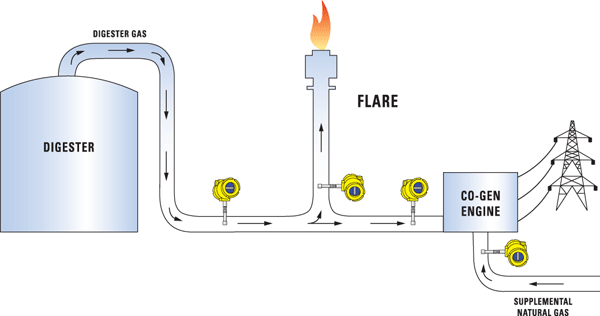Wastewater treatment plant (WWTP) digester processes produce digester gas, a combination of methane (CH4) and carbon dioxide (CO2) with a small percentage of other trace gases. The digester gas composition can vary with the process and temperature (e.g. seasonally) but a typical average is in the 65% (±5%) CH4 35% (±5%) CO2 range. Digester gas is also a wet and dirty gas, typically containing entrained hydrogen sulfides, which condense and deposit on pipe walls and anything else in the pipe.
Modern WWTP processes incorporate digester gas flow meters for:
- Data on digester process performance and control
- Compliance with environmental regulations to report, control and reduce greenhouse gas emissions
- Data for greenhouse gas reduction or carbon credits
- Process control of co-generation systems using digester gas as fuel source

Key Criteria For Flow Meter Selection
- No moving parts to clog or foul
- Simple threaded insertion for easy installation and easy wipe-off cleaning
- Wide turndown for accurate low and high flow rate measuring
- Agency approved for use in Division 2 [Zone 2] and often Division 1 [Zone 1] hazardous environments
- Specifically calibrated for digester gas compositions.
- Direct mass flow measuring
- Temperature compensated flow measurement for accuracy and repeatability in changing ambient and process gas temperatures.
FCI has a broad selection of thermal dispersion flow meters to provide the most effective solution wherever digester gas is measured. FCI flow meters for digester gas applications meet all of the above criteria and feature robust electronics and industrial transmitters that provide the longest service life in WWTP installations.
For line sizes larger than 2.5" [63 mm]
For line sizes 2.0" [51 mm] and smaller